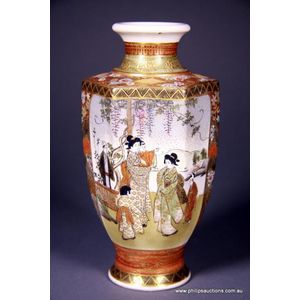Ryokuzan Satsuma Vase with Maidens and Ducks
You must be a subscriber, and be logged in to view price and dealer details.
Subscribe Now to view actual auction price for this item
When you subscribe, you have the option of setting the currency in which to display prices to $Au, $US, $NZ or Stg.
- Diaper Motif - The diaper motif is a repeating geometric pattern in decorative arts that consists of small diamond or lozenge shapes arranged in a grid. The pattern is often used as a background or border on textiles, ceramics, metalwork, and other decorative items. It can be found in a variety of cultures and historical periods, and is often used in formal or ornamental designs. The name "diaper" comes from the pattern's resemblance to the criss-crossed fabric of a baby's diaper.
- Mon - A mon is a Japanese heraldic emblem, indicating the status or the family of the owner, similar to a family crest. Nowadays almost all Japanese families and many businesses have a mon.
In decorative arts, mon are used as a decorative element on a vase, plate, bowl or item of furniture. - Polychrome - Made or finished in many colours. For furniture, it is used to indicated a painted finish.
- Gilding - Gilding is a method of ornamentation whereby a thin sheet of gold metal is applied to items made of wood, leather, ceramics, glass and silver for decorative purposes.
For furniture including mirrors, the sheet of gold is usually applied over a coating of gesso. Gesso is a mixture of plaster of Paris and gypsum mixed with water and then applied to the carved wooden frames of mirrors and picture frames as a base for applying the gold leaf. After numerous coats of gesso have been applied, allowed to dry and then sanded a coat of "bole", a usually red coloured mixture of clay and glue is brushed on and allowed to dry, after which the gold leaf is applied. Over time parts of the gilding will rub off so the base colour can be seen. In water gilding, this was generally a blue colour, while in oil gilding, the under layer was often yellow. In Victorian times, gilders frequently used red as a pigment beneath the gold leaf.
Metal was often gilded by a process known as fire gilding. Gold mixed with mercury was applied and heated, causing the mercury to evaporate, the long-term effect of which was to kill or disable the craftsman or woman from mercury poisoning. The pursuit of beauty has claimed many victims, not the least of which were the artists who made those pieces so highly sought after today. - Oviform /ovoid - The outline loosely resembling the shape of an egg.
This item has been included into following indexes:
Visually similar items

A Satsuma vase. Height 12.5 cm

Large Chinese polychrome vase, decorated with bats

A Satsuma vase, circa 1920s, with the rubbed seal mark of probably Kinkozan tsukuru, the baluster shaped cobalt and gilt patterned vase with large figural panels, one of a deity upon a white elephant with an attendant in mauve, apple green and red colours

A signed Satsuma vase, Meiji period, circa 1900, with signature of Seizan, the hexagonal baluster vase with a flattened collar, embellished with figural narrative scenes within cherry blossom and wisteria landscapes in colours and textured gilding, between
